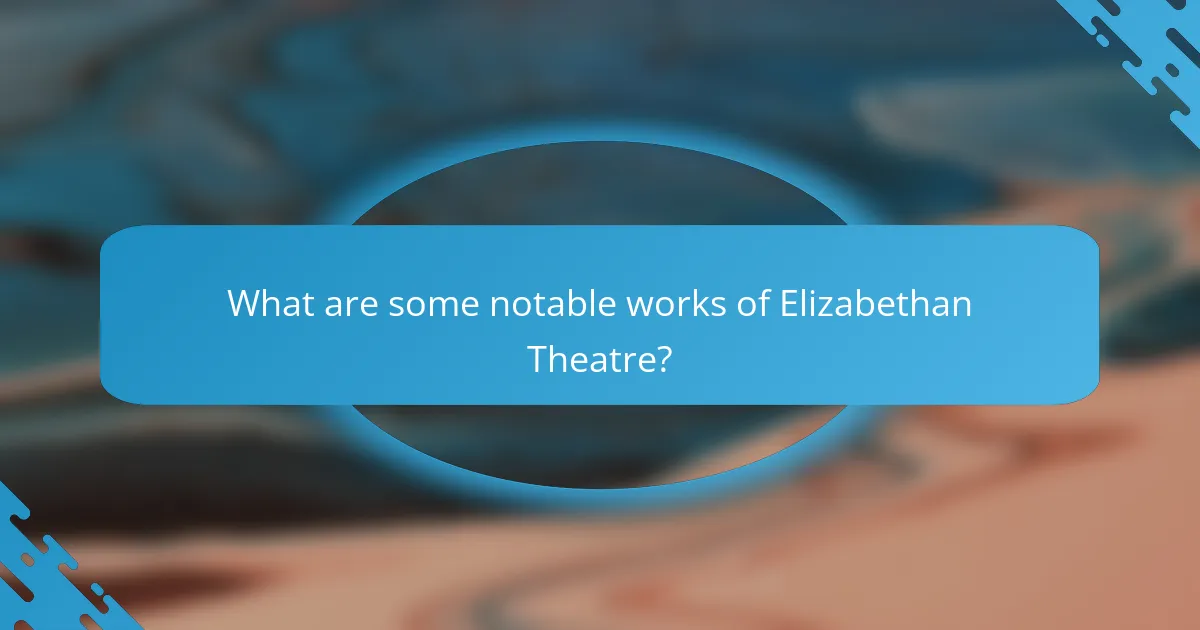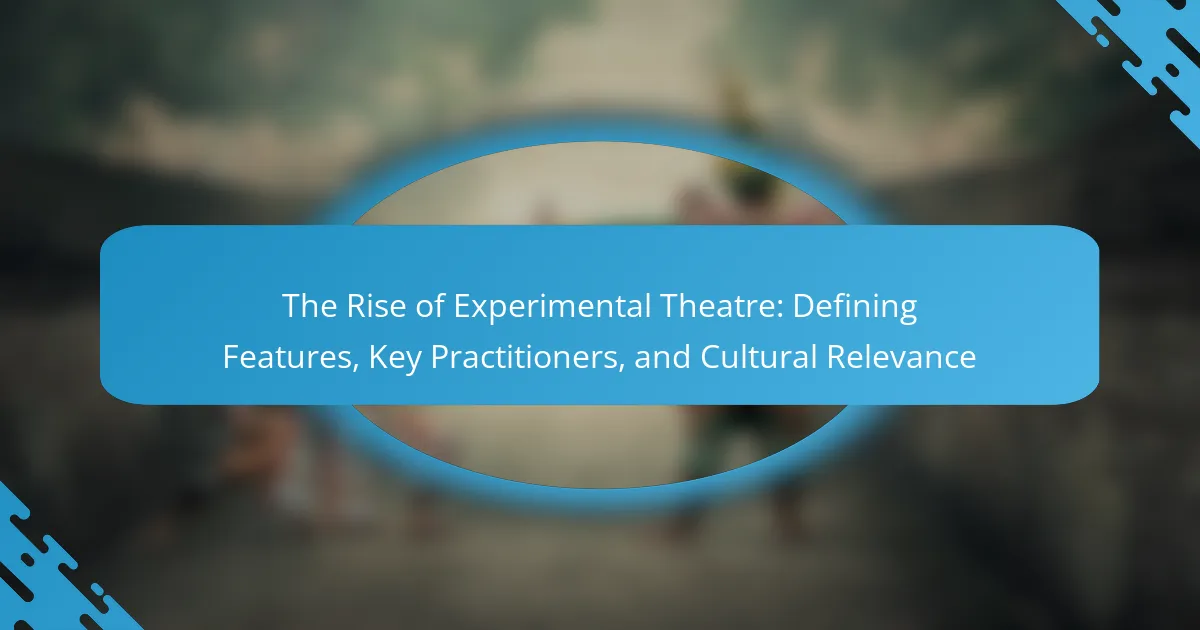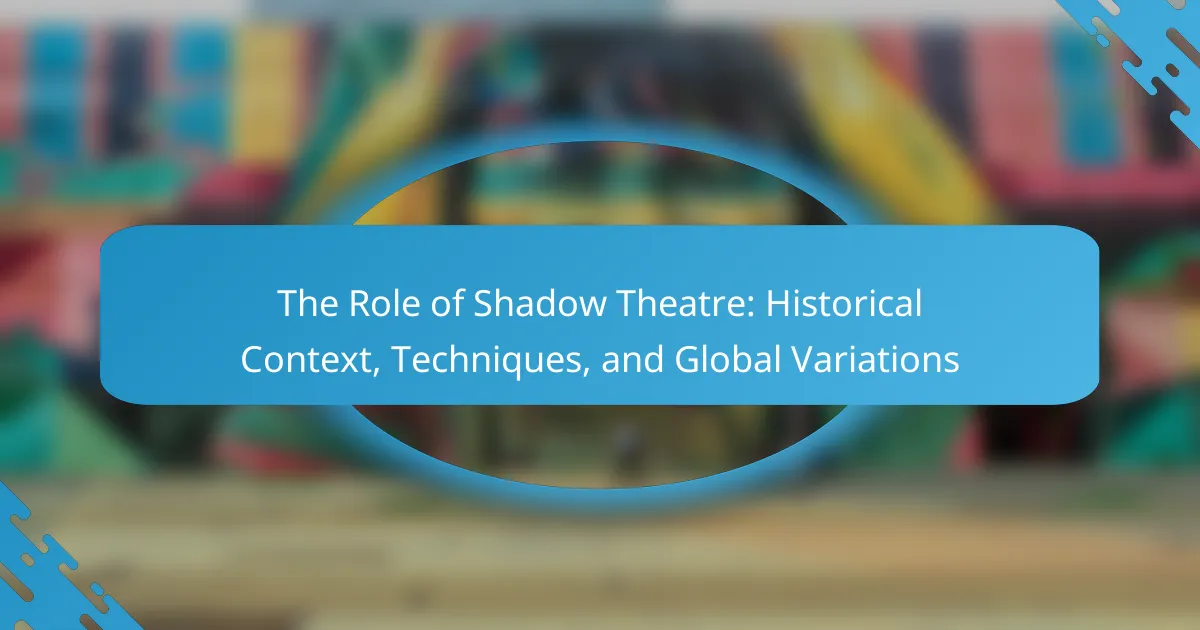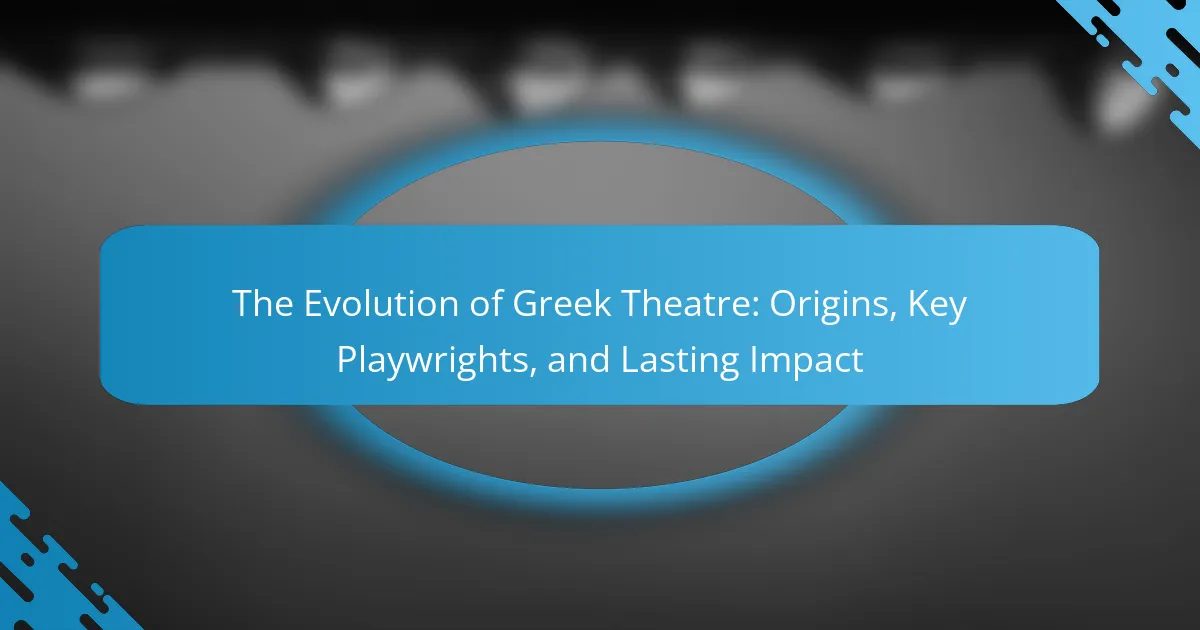Elizabethan Theatre is a significant cultural phenomenon that flourished during the reign of Queen Elizabeth I from 1558 to 1603. It is characterized by elaborate language, diverse themes, and dynamic performances, featuring a blend of tragedy, comedy, and historical narratives that delve into human nature and societal issues. Notable playwrights of this era include William Shakespeare, Christopher Marlowe, and Ben Jonson, whose works exemplify complex characters and intricate plots. The article will explore the defining features of Elizabethan Theatre, its historical context, and the enduring impact of its notable works, providing insights into the thematic elements and theatrical conventions that continue to resonate today.

What are the key characteristics of Elizabethan Theatre?
Elizabethan Theatre is characterized by its use of elaborate language, diverse themes, and dynamic performances. The theatre flourished during the reign of Queen Elizabeth I from 1558 to 1603. It featured a mix of tragedy, comedy, and history, often exploring human nature and societal issues. The plays typically included complex characters and intricate plots. Performances occurred in open-air theatres, like The Globe, allowing for large audiences. Male actors played all roles, including female characters. The staging was minimal, relying on the audience’s imagination. These characteristics contributed to the lasting impact of Elizabethan Theatre on literature and drama.
How did the historical context influence Elizabethan Theatre?
The historical context significantly influenced Elizabethan Theatre through social, political, and cultural factors. The reign of Queen Elizabeth I fostered a climate of relative stability and national pride. This environment encouraged artistic expression and the emergence of professional theatre companies. The influence of the Renaissance brought classical themes and humanist ideas into plays. Additionally, the rise of the middle class created a new audience for theatre. The establishment of the Globe Theatre in 1599 provided a dedicated space for performances. These elements combined to shape the themes and structures of Elizabethan plays, making them diverse and innovative. The historical context, therefore, was crucial in the development of this theatrical period.
What social and political factors shaped the themes of Elizabethan plays?
Social and political factors significantly shaped the themes of Elizabethan plays. The Elizabethan era was marked by political stability under Queen Elizabeth I. This stability encouraged artistic expression and the flourishing of theatre. Additionally, the rise of the middle class influenced themes of ambition and social mobility in plays. The religious tensions of the time also impacted narratives, often reflecting Protestant and Catholic conflicts. Furthermore, the monarchy’s interest in theatre led to state-sponsored performances that promoted royal propaganda. The exploration and colonization during this period introduced themes of adventure and the exotic. Overall, these factors combined to create a rich tapestry of themes in Elizabethan drama.
How did the audience’s demographics affect theatrical performances?
Audience demographics significantly influenced theatrical performances in Elizabethan theatre. The social class of the audience determined the type of plays performed. Wealthy patrons preferred sophisticated, elaborate productions. In contrast, lower-class audiences enjoyed more accessible, comedic performances.
The gender composition also shaped the content and style of plays. Male actors portrayed female roles, reflecting societal norms of the time. Audience age impacted engagement levels; younger viewers often sought entertainment, while older audiences appreciated moral lessons.
Additionally, regional demographics affected language and themes. Performances catered to local dialects and cultural references. Historical records indicate that diverse audiences influenced playwrights like Shakespeare to incorporate universal themes.
This adaptability helped ensure the popularity of theatrical works across different societal segments.
What are the prominent themes found in Elizabethan Theatre?
Prominent themes in Elizabethan Theatre include love, power, and fate. Love often manifests in various forms, such as romantic, familial, and unrequited love. Power dynamics are explored through political intrigue and the consequences of ambition. Fate and destiny frequently appear, highlighting the tension between free will and predetermined outcomes. These themes are evident in works by playwrights like William Shakespeare and Christopher Marlowe. Shakespeare’s “Romeo and Juliet” exemplifies love’s complexities. “Macbeth” illustrates the destructive nature of ambition and power. The theme of fate is central in “Hamlet,” where characters grapple with their destinies. These themes reflect societal concerns of the time, including the nature of humanity and moral dilemmas.
How do love and conflict manifest in Elizabethan plays?
Love and conflict are central themes in Elizabethan plays. They often intertwine, creating dramatic tension. Love can lead to conflict, as seen in Shakespeare’s “Romeo and Juliet.” The feud between the Montagues and Capulets drives the plot. Conflict also arises from societal expectations and family loyalty. Characters frequently face choices between love and duty. This duality enhances emotional stakes in the narrative. Elizabethan playwrights used love to explore human relationships and societal norms. The interplay of love and conflict reflects the complexities of human nature.
What role does fate play in the narratives of Elizabethan Theatre?
Fate plays a significant role in the narratives of Elizabethan Theatre. It often serves as a driving force that shapes characters’ destinies. In many plays, characters struggle against their fates, highlighting the tension between free will and predetermined outcomes. For instance, in Shakespeare’s “Romeo and Juliet,” the concept of “star-crossed lovers” illustrates how fate dictates their tragic end. Similarly, in “Macbeth,” prophecies from the witches set Macbeth on a path of destruction, suggesting that fate can lead to one’s downfall. These examples demonstrate that fate is a central theme, influencing character actions and plot developments throughout Elizabethan drama.
What structural elements define Elizabethan Theatre?
Elizabethan Theatre is characterized by several structural elements. Key features include the open-air stage, which allowed for natural lighting. The thrust stage design brought the audience closer to the performance. The use of trapdoors facilitated dramatic entrances and exits. Galleries provided tiered seating for spectators. The presence of a balcony enabled elevated scenes. Additionally, the stage was often adorned with minimal scenery, relying on the audience’s imagination. These elements combined to create an immersive theatrical experience during the Elizabethan era.
What are the key architectural features of Elizabethan playhouses?
Elizabethan playhouses featured several key architectural elements. They typically had a circular or polygonal shape. The stage was often raised and extended into the audience area. This design allowed for greater audience engagement. Playhouses included a thatched roof over the stage, providing some shelter. They also had an open courtyard for standing spectators, known as “groundlings.” The use of trapdoors was common for dramatic effects. Additionally, the stage was adorned with minimal scenery, relying on dialogue for context. These features contributed to the unique theatrical experience of the time.
How did staging and performance styles contribute to the theatre experience?
Staging and performance styles significantly enhanced the theatre experience during the Elizabethan era. The use of open-air theatres allowed for natural lighting, which created a dynamic atmosphere. Staging techniques included minimal scenery, focusing instead on the actors’ performances and dialogue. This encouraged audience imagination, making the experience more engaging. Performance styles emphasized exaggerated gestures and vocal projection to reach large crowds. Actors often interacted with the audience, breaking the fourth wall and fostering a communal experience. The use of elaborate costumes added visual appeal, enriching character representation. Historical records show that these elements contributed to the popularity of plays, drawing diverse audiences to witness the spectacle.
How did Elizabethan Theatre evolve over time?
Elizabethan Theatre evolved significantly from its inception in the late 16th century. It transitioned from simple, open-air performances to more sophisticated indoor venues. The establishment of the Globe Theatre in 1599 marked a pivotal moment, offering a permanent home for plays. The introduction of elaborate stagecraft and scenic design enhanced visual storytelling. Playwrights like William Shakespeare and Christopher Marlowe pushed the boundaries of narrative complexity and character development. The influence of the Renaissance brought classical themes and humanist ideals into the plays. By the early 17th century, the closure of theatres due to the plague led to a temporary decline. However, the legacy of Elizabethan Theatre continued to shape English drama in subsequent eras.
What were the significant changes in themes and structures throughout the Elizabethan era?
Significant changes in themes and structures occurred throughout the Elizabethan era. The era saw a shift from religious morality plays to secular themes. This transition allowed for exploration of humanism and individualism. Additionally, the structure of plays evolved from simple narratives to complex plots. The use of soliloquies became prominent, allowing characters to express inner thoughts. Furthermore, the introduction of subplots added depth to the main story. The blending of genres, such as tragedy and comedy, also emerged during this time. Notable works by playwrights like Shakespeare exemplified these changes. These developments marked a transformation in the landscape of English theatre.
How did the closure of theatres impact the evolution of Elizabethan Theatre?
The closure of theatres significantly impacted the evolution of Elizabethan Theatre by forcing playwrights to adapt their work for private performances. This led to a shift from public, open-air performances to more intimate settings. Many playwrights began to write plays that could be performed in smaller venues. The closure also encouraged the rise of alternative forms of entertainment, such as masques and private theatricals. This diversification influenced the themes and styles of new works. Playwrights like Shakespeare continued to produce plays, but they were often tailored for court performances. The enforced hiatus ultimately contributed to the development of new theatrical forms. These changes laid the groundwork for the future of English theatre.

What are some notable works of Elizabethan Theatre?
Notable works of Elizabethan Theatre include plays by William Shakespeare, Christopher Marlowe, and Ben Jonson. Shakespeare’s “Hamlet” explores themes of revenge and madness. “Romeo and Juliet” is a tragic love story that highlights the consequences of feuding families. Christopher Marlowe’s “Doctor Faustus” examines ambition and the quest for knowledge. Ben Jonson’s “Volpone” critiques greed and corruption in society. These works are significant for their complex characters and innovative use of language. They reflect the social and political issues of the time, making them enduring pieces of literature.
Who were the most influential playwrights of the Elizabethan era?
The most influential playwrights of the Elizabethan era were William Shakespeare, Christopher Marlowe, and Ben Jonson. William Shakespeare is renowned for his extensive body of work, including plays like “Hamlet” and “Romeo and Juliet.” His writing introduced complex characters and themes that explored the human condition. Christopher Marlowe is known for his pioneering use of blank verse and plays such as “Doctor Faustus.” His work significantly impacted the development of English drama. Ben Jonson, another key figure, is recognized for his satirical comedies, including “Volpone.” His contributions helped shape the theatrical landscape of the time. These playwrights collectively defined the era’s literary excellence and theatrical innovation.
What are the defining characteristics of Shakespeare’s contributions to Elizabethan Theatre?
Shakespeare’s contributions to Elizabethan Theatre are defined by his innovative use of language, complex characters, and exploration of universal themes. He elevated the English language by introducing new vocabulary and poetic forms, enriching dialogue and expression. His characters, such as Hamlet and Lady Macbeth, exhibit deep psychological complexity, making them relatable and multifaceted. Shakespeare’s works often explore themes like love, ambition, and the human condition, resonating with audiences across time. He also popularized the use of soliloquies, providing insight into characters’ thoughts and motivations. His plays were structured to include a mix of tragedy and comedy, appealing to diverse audiences. The Globe Theatre, where many of his plays were performed, allowed for dynamic staging and audience interaction. These defining characteristics solidified Shakespeare’s legacy as a foundational figure in English literature and theatre.
How did Christopher Marlowe’s works differ from those of his contemporaries?
Christopher Marlowe’s works differed from those of his contemporaries primarily in their use of blank verse and complex characters. Marlowe popularized the use of unrhymed iambic pentameter, allowing for greater emotional depth and flexibility. His characters often grappled with profound existential themes, showcasing a range of human emotions and motivations. This contrasts with the more straightforward characterizations seen in the works of playwrights like Thomas Kyd and early Shakespeare. Marlowe’s exploration of themes such as ambition, power, and the human condition set his plays apart. His notable works, such as “Doctor Faustus” and “Tamburlaine,” exemplify these characteristics. These plays delve into the consequences of human desire and ambition, which was less common among his peers. Thus, Marlowe’s innovative style and thematic focus significantly influenced the evolution of Elizabethan theatre.
What are the most celebrated plays from Elizabethan Theatre?
The most celebrated plays from Elizabethan Theatre include works by William Shakespeare, Christopher Marlowe, and Ben Jonson. Shakespeare’s “Hamlet,” “Macbeth,” and “A Midsummer Night’s Dream” are iconic. Christopher Marlowe’s “Doctor Faustus” is also highly regarded. Ben Jonson’s “Volpone” showcases the era’s comedic genius. These plays are celebrated for their complex characters and intricate plots. They reflect the social and political contexts of the time. Shakespeare’s plays, in particular, have had a lasting impact on literature and theatre. They continue to be performed and studied worldwide.
What themes are explored in ‘Hamlet’ and its significance in theatre history?
‘Hamlet’ explores themes such as revenge, madness, mortality, and the complexity of action. The theme of revenge is central, as Hamlet seeks to avenge his father’s murder. Madness is portrayed both as a feigned state and a genuine descent into insanity. Mortality is a recurring concern, highlighted by the iconic graveyard scene. The complexity of action is examined through Hamlet’s hesitations and philosophical reflections. These themes contribute significantly to theatre history by influencing character development and narrative complexity. ‘Hamlet’ set a precedent for psychological depth in drama. Its exploration of existential questions has resonated through centuries, shaping modern theatre.
How does ‘Doctor Faustus’ reflect the values and concerns of its time?
‘Doctor Faustus’ reflects the values and concerns of its time by exploring themes of ambition and the quest for knowledge. The play illustrates the Renaissance humanist belief in the potential of individual achievement. It also critiques the consequences of overreaching ambition and the moral dilemmas associated with pursuing forbidden knowledge. Faustus’s pact with the devil symbolizes the tension between faith and reason prevalent in Elizabethan society. The play addresses the fear of damnation and the uncertainties of the afterlife, mirroring contemporary religious anxieties. Additionally, it showcases the conflict between traditional values and emerging scientific thought during the period. This reflection of societal concerns is evident in Faustus’s tragic downfall, which serves as a cautionary tale about the dangers of hubris.
What impact did Elizabethan Theatre have on modern theatre?
Elizabethan Theatre significantly influenced modern theatre through its innovative storytelling and character development. It introduced complex characters, allowing for deeper emotional connections. The use of soliloquies became a hallmark, providing insight into characters’ thoughts. This technique is still prevalent in contemporary plays. Additionally, the structure of plays during this era, including acts and scenes, laid the groundwork for modern theatrical formats. The emphasis on themes such as love, power, and betrayal remains relevant today. Elizabethan Theatre also popularized the use of diverse genres, blending tragedy and comedy, which continues in modern productions. Its impact is evident in the evolution of stagecraft and performance styles, shaping the theatrical experience we know today.
How have themes and structures from Elizabethan plays influenced contemporary works?
Themes and structures from Elizabethan plays have significantly influenced contemporary works. The use of complex characters and intricate plots is evident in modern storytelling. Elizabethan plays often explored themes of love, power, and betrayal. These themes continue to resonate in today’s literature and film. The structure of five acts in Elizabethan drama is mirrored in many contemporary plays and screenplays. Additionally, the incorporation of soliloquies allows for deeper character introspection. This technique is frequently used in modern narratives to convey internal conflict. The blending of genres seen in Elizabethan theatre is also present in contemporary works, showcasing a fusion of comedy and tragedy. Overall, the foundational elements established during the Elizabethan era remain relevant and influential in today’s artistic expressions.
What lessons can modern playwrights learn from Elizabethan Theatre?
Modern playwrights can learn the importance of strong character development from Elizabethan Theatre. Elizabethan plays often featured complex characters with distinct motivations. Characters like Hamlet and Othello demonstrate deep psychological layers. This complexity engages audiences and fosters emotional investment.
Additionally, modern playwrights can adopt the use of poetic language. Elizabethan playwrights employed iambic pentameter to enhance the rhythm of dialogue. This technique can elevate the emotional impact of contemporary scripts.
Moreover, the incorporation of universal themes is another lesson. Elizabethan Theatre explored themes like love, power, and betrayal. These timeless themes resonate with audiences across generations.
Finally, modern playwrights can appreciate the significance of spectacle. Elizabethan Theatre utilized elaborate staging and costumes to captivate viewers. This emphasis on visual storytelling can enhance modern productions.

How can one appreciate and analyze Elizabethan Theatre today?
One can appreciate and analyze Elizabethan Theatre today by studying its historical context and thematic elements. Understanding the social, political, and cultural background of the Elizabethan era enriches the viewing experience. Theatrical conventions, such as the use of soliloquies and asides, reveal character motivations and themes. Analyzing notable works, like those of Shakespeare and Marlowe, showcases the complexity of human emotion and societal issues. Attending performances in reconstructed venues, like The Globe Theatre, offers insight into original staging practices. Engaging with scholarly critiques and analyses deepens comprehension of the text and its impact. Utilizing modern adaptations can also highlight the relevance of Elizabethan themes in contemporary society. Overall, a multifaceted approach enhances appreciation and understanding of this theatrical period.
What methods can be used to study Elizabethan plays effectively?
To study Elizabethan plays effectively, one can utilize textual analysis, performance studies, and historical context research. Textual analysis involves examining the language, themes, and structures within the plays. This method reveals the intricacies of character development and plot construction. Performance studies focus on how these plays were staged and received by audiences in the Elizabethan era. Historical context research provides insights into the societal and political influences on the playwrights and their works. Each of these methods enhances understanding of the plays’ significance and impact during their time.
How can understanding historical context enhance the appreciation of Elizabethan Theatre?
Understanding historical context enhances appreciation of Elizabethan Theatre by providing insight into its societal influences. The era was marked by the Renaissance, which emphasized humanism and creativity. This cultural backdrop shaped the themes and characters in plays. For example, the influence of political events, like the reign of Queen Elizabeth I, informed the content and style of performances. Additionally, the presence of the plague impacted theatre attendance and production. Recognizing these historical factors allows audiences to grasp deeper meanings in the works. It also highlights the significance of playwrights like Shakespeare, who responded to their environment. Overall, historical context enriches the viewing experience by connecting audiences to the era’s complexities.
What resources are available for exploring Elizabethan Theatre?
Books on Elizabethan Theatre include “Shakespeare’s Theatre” by Richard Hornby and “The Cambridge Companion to Shakespeare on Stage” edited by James C. Bulman. These texts provide insights into the historical context and structure of the theatre. Online databases like JSTOR and Project MUSE offer academic articles on Elizabethan plays and playwrights. The Royal Shakespeare Company’s website features resources on performances and educational materials. Additionally, the Folger Shakespeare Library provides access to original texts and critical essays. The British Library hosts digitized manuscripts and historical documents related to the period. These resources enable comprehensive exploration of Elizabethan Theatre.
What are some recommended readings and adaptations of Elizabethan plays?
Recommended readings of Elizabethan plays include works by William Shakespeare, Christopher Marlowe, and Ben Jonson. Shakespeare’s “Hamlet,” “Macbeth,” and “A Midsummer Night’s Dream” are essential texts. Christopher Marlowe’s “Doctor Faustus” and “Tamburlaine” are also significant. Ben Jonson’s “Volpone” and “The Alchemist” showcase the era’s comedic elements.
Adaptations of these plays are prevalent in modern theatre and film. Notable adaptations include the film “West Side Story,” which is based on Shakespeare’s “Romeo and Juliet.” The Royal Shakespeare Company’s productions often reinterpret Shakespeare’s works for contemporary audiences. Additionally, the Globe Theatre in London frequently stages Elizabethan plays, maintaining their original context while making them accessible today.
How can attending performances help in understanding the nuances of Elizabethan Theatre?
Attending performances enhances understanding of Elizabethan Theatre by providing firsthand experience of its unique characteristics. Live performances showcase the language, rhythm, and delivery of the dialogue, which are crucial to the genre. Observing actors’ interpretations reveals the emotional depth and complexity of characters. The staging and use of space illustrate the physicality and dynamics of the performances. Audience reactions during a live show highlight the communal aspect of theatre in that era. Historical context, such as the use of minimal sets and reliance on audience imagination, becomes clearer through observation. Additionally, performances illuminate the thematic elements prevalent in Elizabethan works, such as love, power, and betrayal. Engaging with the live art form fosters a deeper appreciation for the cultural significance of the period.
The main entity of the article is Elizabethan Theatre, a significant cultural phenomenon during the reign of Queen Elizabeth I from 1558 to 1603. The article explores key characteristics such as its elaborate language, diverse themes, and dynamic performances, highlighting the influence of historical context on its development. It examines social and political factors that shaped the themes of the plays, the demographics of the audience, and the structural elements defining the theatre experience. Notable works and playwrights, including William Shakespeare and Christopher Marlowe, are discussed, along with the lasting impact of Elizabethan Theatre on modern drama and the lessons contemporary playwrights can learn from this era.



